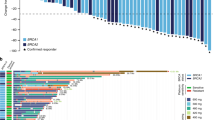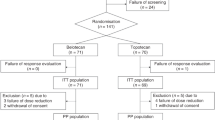Abstract
Objectives. The Gynecologic Oncology Group (GOG) performed a randomized phase II study to determine the antitumor activity and toxicity of two different schedules of bryostatin-1 administration in patients with recurrent or persistent platinum-sensitive epithelial ovarian cancer or primary peritoneal carcinoma. Methods. Eligible patients were randomized to receive either bryostatin-1 25μg/m2 as a 1h infusion weekly for 3 weeks followed by a 1-week rest (Regimen I) or bryostatin-1 120μg/m2 as a 72h continuous infusion every 2 weeks (Regimen II). Results. Fifty-five patients were enrolled on this study. There was one durable response among 27 eligible patients (response rate=3.7%) on Regimen II and no responses in the 27 eligible patients on Regimen I. Nineteen patients (eleven on Regimen I and eight on Regimen II) had stable disease. The most common adverse event was myalgia, with 12 of 27 patients (44%) on each regimen experiencing some degree of myalgia. There were no other significant toxicities on either treatment arm. Conclusions. Both of these schedules and doses of bryostatin-1 are inactive as single agents in previously treated epithelial ovarian cancer.
Similar content being viewed by others
References
Greenlee RT, Hill-Harmon MB, Murray T, Thun M: Cancer statistics. CA Cancer J Clin 51(1): 15–36, 2001
Ozols RF, Rubin SC, Thomas G, Robboy S: Epithelial ovarian cancer. In: Hoskins WJ, Perez CA, Young RC (eds) Principles and Practice of Gynecologic Oncology, 2nd edn. Lippincott-Raven, Philadalphia, PA, 1997, pp 919–986
McGuire WP, Hoskins WJ, Brady MF, Kucera PR, Partridge EE, Look KY, Clarke-Pearson DL, Davidson M: Cyclophosphamide and cisplatin compared with paclitaxel and cisplatin in patients with stage III and stage IV ovarian cancer. N Engl J Med 334(1): 1–6, 1996
Pettit GR, Herald CL, Doubek DL, Herald D: Isolation and structure of bryostatin-1. J Am Chem Soc 104: 6846–6848, 1982
Mutter R, Wills M: Chemistry and clinical biology of the bryostatins. Bioorg Med Chem 8(8): 1841–1860, 2000
Philip PA, Zonder JA: Pharmacology and clinical experience with bryostatin-1: a novel anticancer drug. Expert Opin Investig Drugs 8(12): 2189–2199, 1999
Prendiville J, Crowther D, Thatcher N, Woll PJ, Fox BW, McGown A, Testa N, Stern P, McDermott R, Potter M: A phase I study of intravenous bryostatin-1 in patients with advanced cancer. Br J Cancer 68(2): 418–424, 1993
O'Reilly S, Slichenmyer W, Hess A, Donehower R: A phase I and immunologic study of bryostatin-1 in patients with solid tumors. Proc Amer Assoc Cancer Res 56: 802–808, 1996
Barry OP, Kazanietz MG: Protein kinase c isozymes, novel phorbol ester receptors and cancer chemotherapy. Curr Pharm Des 7(17): 1725–1744, 2001
Carter CA: Protein kinase C as a drug target: implications for drug or diet prevention and treatment of cancer. Curr Drug Targets 1(2): 163–183, 2000
Basu A, Lazo JS: Sensitization of human cervical carcinoma cells to cisdiamminedichloroplatinum (II) by bryostatin-1. Cancer Res 52(11): 3119–3124, 1992
Wang S, Wang Z, Boise LH, Dent P, Grant S: Bryostatin-1 enhances paclitaxel induced mitochondrial dysfunction and apoptosis in human leukemia cells (U927) ectopically expressing Bcl-xL. Leukemia 13(10): 1564–1573, 1999
Koutcher JA, Motwani M, Zakian KL, Li XK, Matei C, Dyke JP, Ballon D, Yoo HH, Schwartz GK: The in vivo effect of bryostatin-1 on paclitaxel-induced tumor growth, mitotic entry, and blood flow. Clin Cancer Res 6(4): 1498–1507, 2000
Mohammad RM, Wall NR, Dutcher JA, Al-Katib AM: The addition of bryostatin-1 to cyclophosphamide, doxorubicin, vincristine, and prednisone (CHOP) chemotherapy improves response in a CHOP-resistant human diffuse large cell lymphoma xenograft model. Clin Cancer Res 6(12): 4950–4956, 2000
Zaugg K, Rocha S, Resch H, Hegyi I, Oehler C, Glanzmann C, Fabbro D, Bodis S, Pruschy M: Differential p53–dependent mechanism of radiosensitization in vitro and in vivo by the protein kinase C-specific inhibitor PKC412. Cancer Res 61(2): 832–838, 2001
Author information
Authors and Affiliations
Rights and permissions
About this article
Cite this article
Armstrong, D.K., Blessing, J.A., Look, K.Y. et al. A randomized phase II evaluation of bryostatin-1 (NSC #339555) in recurrent or persistent platinum-sensitive ovarian cancer: A Gynecologic Oncology Group Study. Invest New Drugs 21, 373–377 (2003). https://doi.org/10.1023/A:1025490818450
Issue Date:
DOI: https://doi.org/10.1023/A:1025490818450




